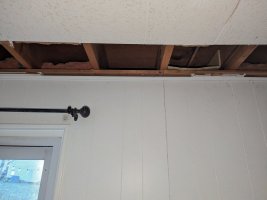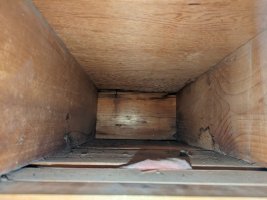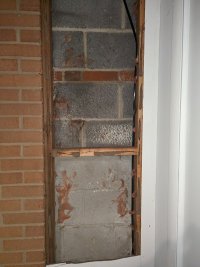Djford88
New Member
Hello All,
Looking for comments on my strategy to insulate the basement in my split foyer home built in the 1960s. Walk out on the back side with partially buried walls on the front and sides (graded up the side walls to about 3 foot buried walls in the front) living in zone 4A (we get all four seasons here in VA, cold to 10 degrees, warm to 90degrees and humid). The basement is built on a concrete pad with cinderblock (CMU) walls. I don't believe the pad was insulated because the floor is pretty cold.
Currently, the insulation situation is this: dirty and loose batts in the walls and cantilevers. Air leaks abound. I have attached pictures. It's very cold.
I've scoured the forums for information and I really appreciate all the knowledge. I think the following plan makes sense for 4a:
Cantilever:
1) Seal wood to wood intersections and gaps with froth pak sealant or polyurethane caulk, whichever I can fit in the space.
then two options:
a) Roxull batts filling up the 2x10 space, then polyiso board cut to fit into the joist bays and seal. This is what I used when I did about with 14 joist bays in my laundry room 2 years ago
OR
b) "Drill and fill" Cut poly-iso to form an air barrier at sill plate/joist bay intersection, seal it into the bay, cut out a hole then fill the bays with cellulose. I don't think I'll be able to "dense pack" with the big box rental machines though, is this a problem?
Sill Plate: Same strategy at the cantilevers, but could use advice on *exactly* where to apply foam
Walls: I don't have a well formed strategy with the walls, I know a vapor barrier isn't required in 4a. I just don't want to create a moisture issue.
1) Slide 1/4" (fanfold) or 1/2" (can't find 1/2" fanfold) XPS foam board in the 1/2" space between the CMU and stud wall, then tape seams with JointSealR, then
2) Staple cellulose netting to the studs and fill with cellulose.
3) Contract out to drywallers to finish drywall
Concrete Pad: Barely researched the third component here but I hear dricore or dmx 1-step are two options, not sure exactly which product to use. They're pretty thick so I know walls, doorways would need to addressed.
Looks like Dana hasn't posted in over a year and has been AFK from these forums since October so I'm hoping someone else can chime in! Thank you!
Looking for comments on my strategy to insulate the basement in my split foyer home built in the 1960s. Walk out on the back side with partially buried walls on the front and sides (graded up the side walls to about 3 foot buried walls in the front) living in zone 4A (we get all four seasons here in VA, cold to 10 degrees, warm to 90degrees and humid). The basement is built on a concrete pad with cinderblock (CMU) walls. I don't believe the pad was insulated because the floor is pretty cold.
Currently, the insulation situation is this: dirty and loose batts in the walls and cantilevers. Air leaks abound. I have attached pictures. It's very cold.
I've scoured the forums for information and I really appreciate all the knowledge. I think the following plan makes sense for 4a:
Cantilever:
1) Seal wood to wood intersections and gaps with froth pak sealant or polyurethane caulk, whichever I can fit in the space.
then two options:
a) Roxull batts filling up the 2x10 space, then polyiso board cut to fit into the joist bays and seal. This is what I used when I did about with 14 joist bays in my laundry room 2 years ago
OR
b) "Drill and fill" Cut poly-iso to form an air barrier at sill plate/joist bay intersection, seal it into the bay, cut out a hole then fill the bays with cellulose. I don't think I'll be able to "dense pack" with the big box rental machines though, is this a problem?
Sill Plate: Same strategy at the cantilevers, but could use advice on *exactly* where to apply foam
Walls: I don't have a well formed strategy with the walls, I know a vapor barrier isn't required in 4a. I just don't want to create a moisture issue.
1) Slide 1/4" (fanfold) or 1/2" (can't find 1/2" fanfold) XPS foam board in the 1/2" space between the CMU and stud wall, then tape seams with JointSealR, then
2) Staple cellulose netting to the studs and fill with cellulose.
3) Contract out to drywallers to finish drywall
Concrete Pad: Barely researched the third component here but I hear dricore or dmx 1-step are two options, not sure exactly which product to use. They're pretty thick so I know walls, doorways would need to addressed.
Looks like Dana hasn't posted in over a year and has been AFK from these forums since October so I'm hoping someone else can chime in! Thank you!
Attachments
Last edited:






